The Impact of Accounting Variables on Stock Price: NEPSE Analysis
VerifiedAdded on 2023/04/25
|20
|4065
|435
Report
AI Summary
This research report investigates the impact of accounting variables, including Earnings Per Share (EPS), Dividend Per Share (DPS), and Book Value Per Share (BVPS), on stock prices within the Nepal Stock Exchange (NEPSE). The study aims to determine the relationships between these variables and stock valuation, providing insights for investors and market analysts. The report includes an introduction, problem statement, research aims and objectives, justification of the project, and potential research outputs. It also covers the conceptual framework, research methodology (interpretivism research philosophy, qualitative research design, secondary data collection, and literature review research strategy), project budget, and references. The findings are expected to shed light on how accounting variables influence stock prices, offering valuable information for understanding the dynamics of the Nepalese stock market. The report highlights the significance of EPS, DPS, and BVPS as key indicators affecting stock performance and provides a detailed analysis of their influence on the NEPSE.

Impact of accounting variables on stock price: Evidence from the Nepal Stock Exchange
2 / 6 / 2 0 1 9
2 / 6 / 2 0 1 9
Paraphrase This Document
Need a fresh take? Get an instant paraphrase of this document with our AI Paraphraser

Research 1
Abstract
In the present research, the impact of accounting variables on stock price has been done that is
evident from the Nepal Stock Exchange. This has been found that stock price depends majorly
on the internal as well as the external factors. This research focuses on the internal factors; the
firm's specific factors majorly include earning per share (EPS), dividend per share (DPS) and
book value per share (BVPS) create the impact of determination of the stock price. The current
research examines the influence of the accounting variables on the Nepal Stock Exchange that is
NEPSE. The research has been done with the use of the second method with qualitative research.
Abstract
In the present research, the impact of accounting variables on stock price has been done that is
evident from the Nepal Stock Exchange. This has been found that stock price depends majorly
on the internal as well as the external factors. This research focuses on the internal factors; the
firm's specific factors majorly include earning per share (EPS), dividend per share (DPS) and
book value per share (BVPS) create the impact of determination of the stock price. The current
research examines the influence of the accounting variables on the Nepal Stock Exchange that is
NEPSE. The research has been done with the use of the second method with qualitative research.

Research 2
Contents
Introduction......................................................................................................................................3
Problem Statement.......................................................................................................................3
Aim and objectives/ research questions.......................................................................................4
Justification and Potential Output of the research...........................................................................4
Justification of the project...........................................................................................................4
Potential Research Output...........................................................................................................4
Conceptual Framework and Hypothesis Development...................................................................5
Research Methodology....................................................................................................................8
The organisation of the Study........................................................................................................11
Introduction................................................................................................................................11
Literature Review......................................................................................................................11
Research Methodology..............................................................................................................12
Data Analysis.............................................................................................................................12
Discussion..................................................................................................................................12
Conclusion.................................................................................................................................13
Project Budget and Budget Justification........................................................................................13
References......................................................................................................................................16
Appendix........................................................................................................................................18
Contents
Introduction......................................................................................................................................3
Problem Statement.......................................................................................................................3
Aim and objectives/ research questions.......................................................................................4
Justification and Potential Output of the research...........................................................................4
Justification of the project...........................................................................................................4
Potential Research Output...........................................................................................................4
Conceptual Framework and Hypothesis Development...................................................................5
Research Methodology....................................................................................................................8
The organisation of the Study........................................................................................................11
Introduction................................................................................................................................11
Literature Review......................................................................................................................11
Research Methodology..............................................................................................................12
Data Analysis.............................................................................................................................12
Discussion..................................................................................................................................12
Conclusion.................................................................................................................................13
Project Budget and Budget Justification........................................................................................13
References......................................................................................................................................16
Appendix........................................................................................................................................18
⊘ This is a preview!⊘
Do you want full access?
Subscribe today to unlock all pages.

Trusted by 1+ million students worldwide
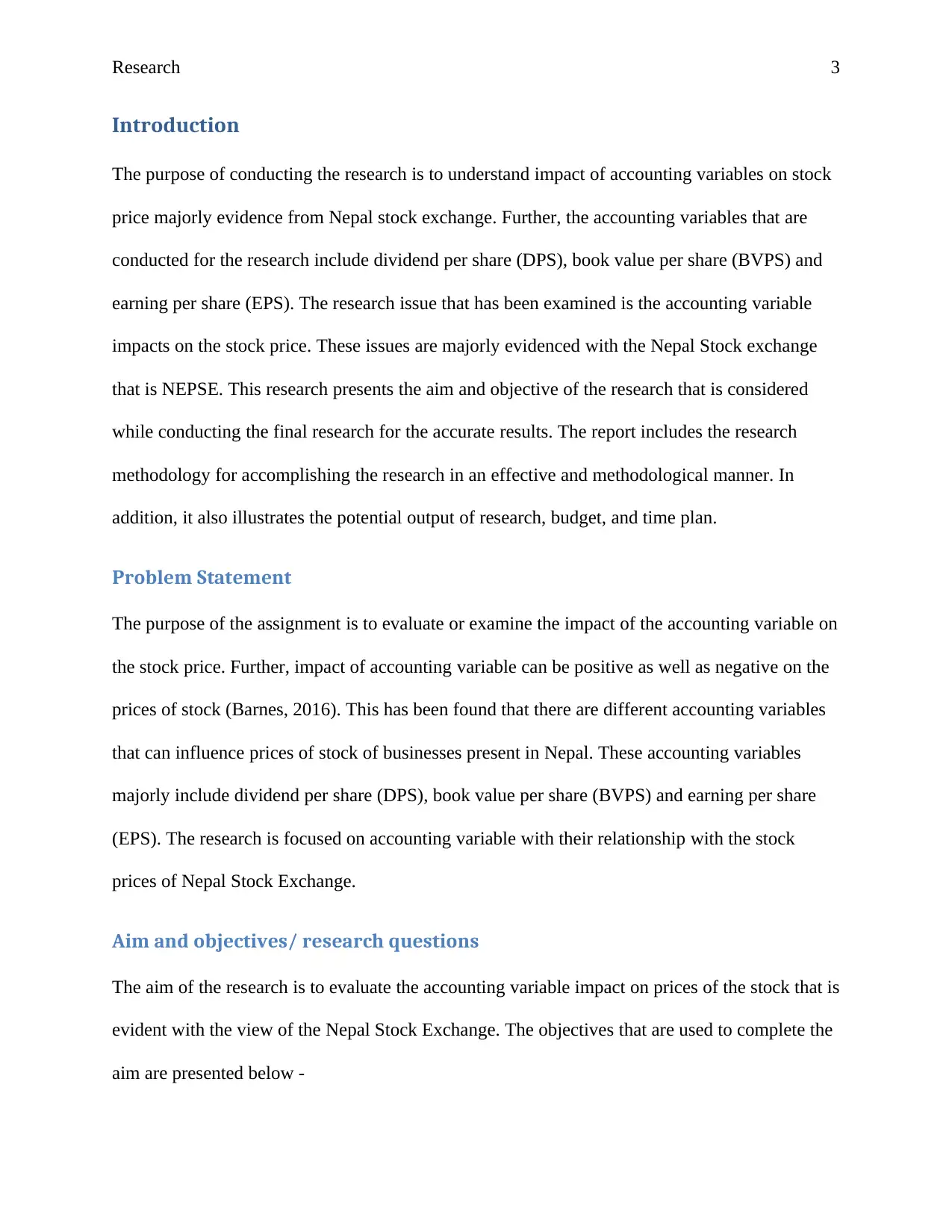
Research 3
Introduction
The purpose of conducting the research is to understand impact of accounting variables on stock
price majorly evidence from Nepal stock exchange. Further, the accounting variables that are
conducted for the research include dividend per share (DPS), book value per share (BVPS) and
earning per share (EPS). The research issue that has been examined is the accounting variable
impacts on the stock price. These issues are majorly evidenced with the Nepal Stock exchange
that is NEPSE. This research presents the aim and objective of the research that is considered
while conducting the final research for the accurate results. The report includes the research
methodology for accomplishing the research in an effective and methodological manner. In
addition, it also illustrates the potential output of research, budget, and time plan.
Problem Statement
The purpose of the assignment is to evaluate or examine the impact of the accounting variable on
the stock price. Further, impact of accounting variable can be positive as well as negative on the
prices of stock (Barnes, 2016). This has been found that there are different accounting variables
that can influence prices of stock of businesses present in Nepal. These accounting variables
majorly include dividend per share (DPS), book value per share (BVPS) and earning per share
(EPS). The research is focused on accounting variable with their relationship with the stock
prices of Nepal Stock Exchange.
Aim and objectives/ research questions
The aim of the research is to evaluate the accounting variable impact on prices of the stock that is
evident with the view of the Nepal Stock Exchange. The objectives that are used to complete the
aim are presented below -
Introduction
The purpose of conducting the research is to understand impact of accounting variables on stock
price majorly evidence from Nepal stock exchange. Further, the accounting variables that are
conducted for the research include dividend per share (DPS), book value per share (BVPS) and
earning per share (EPS). The research issue that has been examined is the accounting variable
impacts on the stock price. These issues are majorly evidenced with the Nepal Stock exchange
that is NEPSE. This research presents the aim and objective of the research that is considered
while conducting the final research for the accurate results. The report includes the research
methodology for accomplishing the research in an effective and methodological manner. In
addition, it also illustrates the potential output of research, budget, and time plan.
Problem Statement
The purpose of the assignment is to evaluate or examine the impact of the accounting variable on
the stock price. Further, impact of accounting variable can be positive as well as negative on the
prices of stock (Barnes, 2016). This has been found that there are different accounting variables
that can influence prices of stock of businesses present in Nepal. These accounting variables
majorly include dividend per share (DPS), book value per share (BVPS) and earning per share
(EPS). The research is focused on accounting variable with their relationship with the stock
prices of Nepal Stock Exchange.
Aim and objectives/ research questions
The aim of the research is to evaluate the accounting variable impact on prices of the stock that is
evident with the view of the Nepal Stock Exchange. The objectives that are used to complete the
aim are presented below -
Paraphrase This Document
Need a fresh take? Get an instant paraphrase of this document with our AI Paraphraser
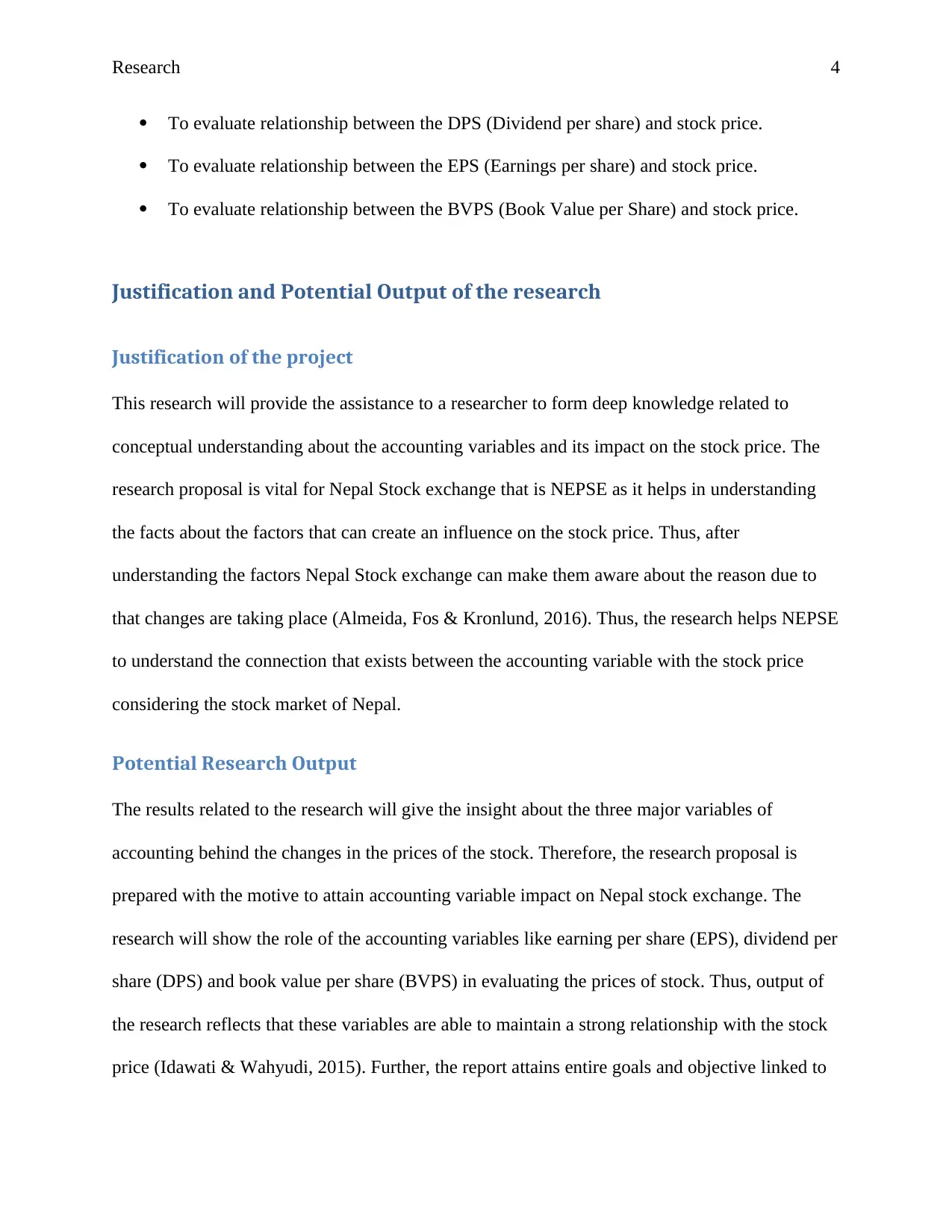
Research 4
To evaluate relationship between the DPS (Dividend per share) and stock price.
To evaluate relationship between the EPS (Earnings per share) and stock price.
To evaluate relationship between the BVPS (Book Value per Share) and stock price.
Justification and Potential Output of the research
Justification of the project
This research will provide the assistance to a researcher to form deep knowledge related to
conceptual understanding about the accounting variables and its impact on the stock price. The
research proposal is vital for Nepal Stock exchange that is NEPSE as it helps in understanding
the facts about the factors that can create an influence on the stock price. Thus, after
understanding the factors Nepal Stock exchange can make them aware about the reason due to
that changes are taking place (Almeida, Fos & Kronlund, 2016). Thus, the research helps NEPSE
to understand the connection that exists between the accounting variable with the stock price
considering the stock market of Nepal.
Potential Research Output
The results related to the research will give the insight about the three major variables of
accounting behind the changes in the prices of the stock. Therefore, the research proposal is
prepared with the motive to attain accounting variable impact on Nepal stock exchange. The
research will show the role of the accounting variables like earning per share (EPS), dividend per
share (DPS) and book value per share (BVPS) in evaluating the prices of stock. Thus, output of
the research reflects that these variables are able to maintain a strong relationship with the stock
price (Idawati & Wahyudi, 2015). Further, the report attains entire goals and objective linked to
To evaluate relationship between the DPS (Dividend per share) and stock price.
To evaluate relationship between the EPS (Earnings per share) and stock price.
To evaluate relationship between the BVPS (Book Value per Share) and stock price.
Justification and Potential Output of the research
Justification of the project
This research will provide the assistance to a researcher to form deep knowledge related to
conceptual understanding about the accounting variables and its impact on the stock price. The
research proposal is vital for Nepal Stock exchange that is NEPSE as it helps in understanding
the facts about the factors that can create an influence on the stock price. Thus, after
understanding the factors Nepal Stock exchange can make them aware about the reason due to
that changes are taking place (Almeida, Fos & Kronlund, 2016). Thus, the research helps NEPSE
to understand the connection that exists between the accounting variable with the stock price
considering the stock market of Nepal.
Potential Research Output
The results related to the research will give the insight about the three major variables of
accounting behind the changes in the prices of the stock. Therefore, the research proposal is
prepared with the motive to attain accounting variable impact on Nepal stock exchange. The
research will show the role of the accounting variables like earning per share (EPS), dividend per
share (DPS) and book value per share (BVPS) in evaluating the prices of stock. Thus, output of
the research reflects that these variables are able to maintain a strong relationship with the stock
price (Idawati & Wahyudi, 2015). Further, the report attains entire goals and objective linked to
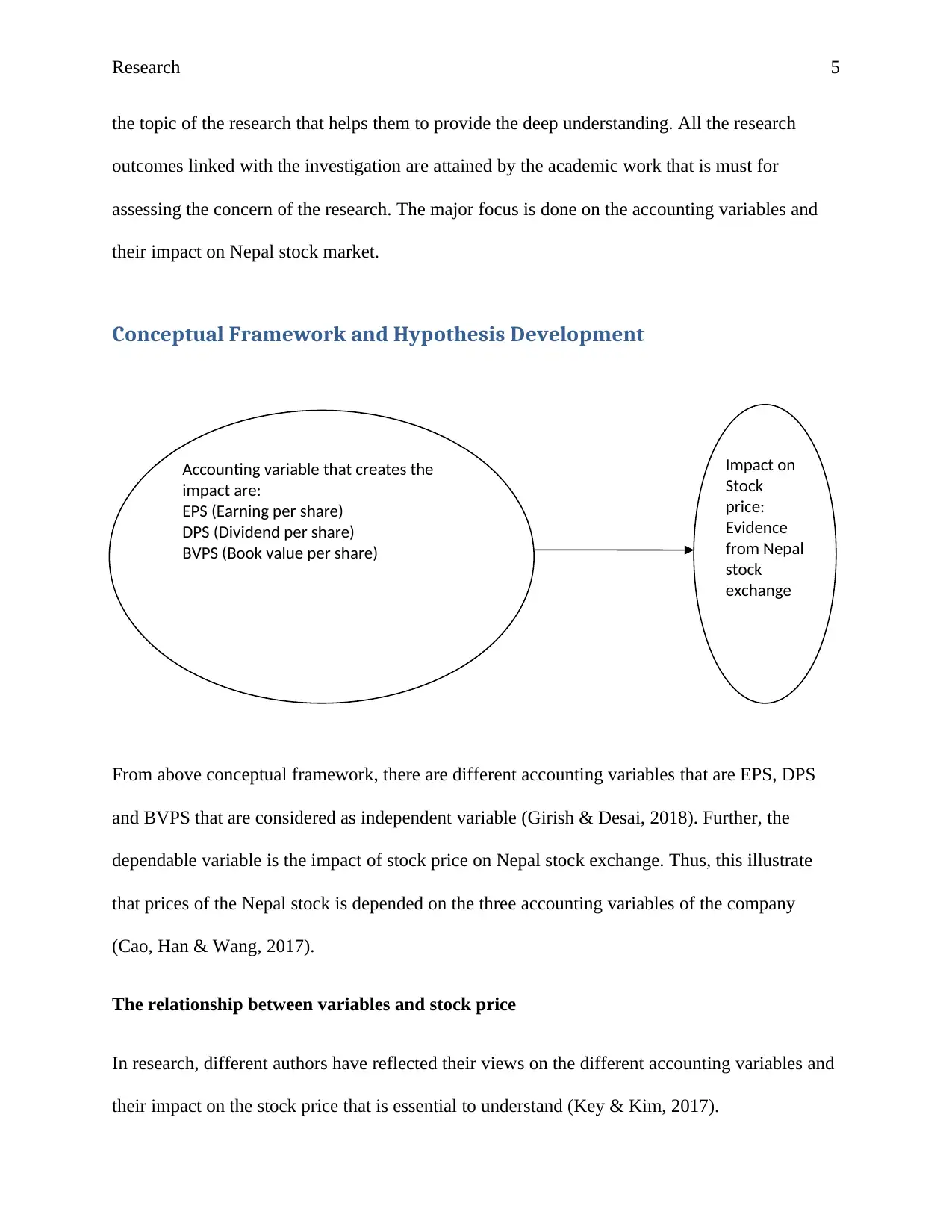
Research 5
the topic of the research that helps them to provide the deep understanding. All the research
outcomes linked with the investigation are attained by the academic work that is must for
assessing the concern of the research. The major focus is done on the accounting variables and
their impact on Nepal stock market.
Conceptual Framework and Hypothesis Development
From above conceptual framework, there are different accounting variables that are EPS, DPS
and BVPS that are considered as independent variable (Girish & Desai, 2018). Further, the
dependable variable is the impact of stock price on Nepal stock exchange. Thus, this illustrate
that prices of the Nepal stock is depended on the three accounting variables of the company
(Cao, Han & Wang, 2017).
The relationship between variables and stock price
In research, different authors have reflected their views on the different accounting variables and
their impact on the stock price that is essential to understand (Key & Kim, 2017).
Accounting variable that creates the
impact are:
EPS (Earning per share)
DPS (Dividend per share)
BVPS (Book value per share)
Impact on
Stock
price:
Evidence
from Nepal
stock
exchange
the topic of the research that helps them to provide the deep understanding. All the research
outcomes linked with the investigation are attained by the academic work that is must for
assessing the concern of the research. The major focus is done on the accounting variables and
their impact on Nepal stock market.
Conceptual Framework and Hypothesis Development
From above conceptual framework, there are different accounting variables that are EPS, DPS
and BVPS that are considered as independent variable (Girish & Desai, 2018). Further, the
dependable variable is the impact of stock price on Nepal stock exchange. Thus, this illustrate
that prices of the Nepal stock is depended on the three accounting variables of the company
(Cao, Han & Wang, 2017).
The relationship between variables and stock price
In research, different authors have reflected their views on the different accounting variables and
their impact on the stock price that is essential to understand (Key & Kim, 2017).
Accounting variable that creates the
impact are:
EPS (Earning per share)
DPS (Dividend per share)
BVPS (Book value per share)
Impact on
Stock
price:
Evidence
from Nepal
stock
exchange
⊘ This is a preview!⊘
Do you want full access?
Subscribe today to unlock all pages.

Trusted by 1+ million students worldwide

Research 6
EPS and Stock Price
According to Hassan & Haque (2017), the first and foremost step in understanding the
connection among the value of a stock and its earnings is to consider the earning per share (EPS).
EPS is used with the motive to evaluate the amount of the incomes that are generated by the
company for the each and every share of the stock. Further, the researcher has explained the
same with the help of the example that is: - let assume that the company pays no dividends- if an
organisation or business has $10,000 in earning and approx. of 1,000 shares then the EPS of the
company would be equal to $10,000 that is divided by $1,000 or $10. This is considered as one
of the obligations of the company that they are supposed to accomplish for their shareholders and
investors. On the other hand, Omokhudu & Ibadin, (2015) said that the firms earning per share is
generally of the interest to current stockholder and to the management. The amount that is earned
at the time of the accounting period on every outstanding of common stock is calculated by
dividing the whole earning of company by number of common stock outstanding.
DPS and Stock Price
According to the Nguyen, Duong & Singh (2016), the percentage of the earning that the firms
pay to their stakeholders in terms of the cash is majorly known as the dividend. Thus, it has been
found that it reduces the amount of retained earnings in the organisation how it affects the total
amount of financing through the internal sources. The researcher of the author says that nothing
is more prior and vital than the dividends to the stakeholders of the company. Another Shilling,
(2017) exhibits that the stakeholders of the company making the purchase of the organisation
share with the motive of sharing the profit that is attained by the firms. It has been found in the
research that the sole motive of the stockholders is to attain the returns on the investment that
EPS and Stock Price
According to Hassan & Haque (2017), the first and foremost step in understanding the
connection among the value of a stock and its earnings is to consider the earning per share (EPS).
EPS is used with the motive to evaluate the amount of the incomes that are generated by the
company for the each and every share of the stock. Further, the researcher has explained the
same with the help of the example that is: - let assume that the company pays no dividends- if an
organisation or business has $10,000 in earning and approx. of 1,000 shares then the EPS of the
company would be equal to $10,000 that is divided by $1,000 or $10. This is considered as one
of the obligations of the company that they are supposed to accomplish for their shareholders and
investors. On the other hand, Omokhudu & Ibadin, (2015) said that the firms earning per share is
generally of the interest to current stockholder and to the management. The amount that is earned
at the time of the accounting period on every outstanding of common stock is calculated by
dividing the whole earning of company by number of common stock outstanding.
DPS and Stock Price
According to the Nguyen, Duong & Singh (2016), the percentage of the earning that the firms
pay to their stakeholders in terms of the cash is majorly known as the dividend. Thus, it has been
found that it reduces the amount of retained earnings in the organisation how it affects the total
amount of financing through the internal sources. The researcher of the author says that nothing
is more prior and vital than the dividends to the stakeholders of the company. Another Shilling,
(2017) exhibits that the stakeholders of the company making the purchase of the organisation
share with the motive of sharing the profit that is attained by the firms. It has been found in the
research that the sole motive of the stockholders is to attain the returns on the investment that
Paraphrase This Document
Need a fresh take? Get an instant paraphrase of this document with our AI Paraphraser
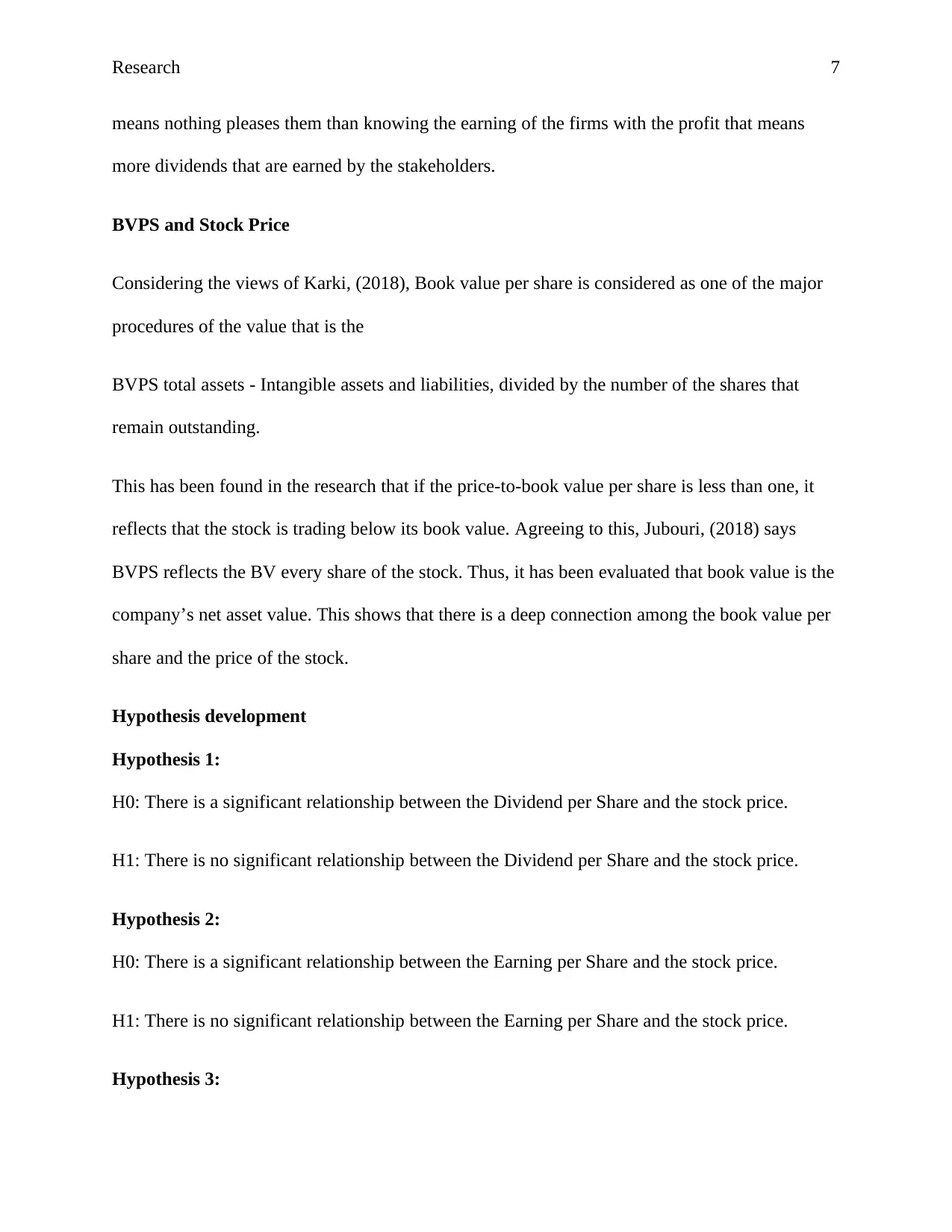
Research 7
means nothing pleases them than knowing the earning of the firms with the profit that means
more dividends that are earned by the stakeholders.
BVPS and Stock Price
Considering the views of Karki, (2018), Book value per share is considered as one of the major
procedures of the value that is the
BVPS total assets - Intangible assets and liabilities, divided by the number of the shares that
remain outstanding.
This has been found in the research that if the price-to-book value per share is less than one, it
reflects that the stock is trading below its book value. Agreeing to this, Jubouri, (2018) says
BVPS reflects the BV every share of the stock. Thus, it has been evaluated that book value is the
company’s net asset value. This shows that there is a deep connection among the book value per
share and the price of the stock.
Hypothesis development
Hypothesis 1:
H0: There is a significant relationship between the Dividend per Share and the stock price.
H1: There is no significant relationship between the Dividend per Share and the stock price.
Hypothesis 2:
H0: There is a significant relationship between the Earning per Share and the stock price.
H1: There is no significant relationship between the Earning per Share and the stock price.
Hypothesis 3:
means nothing pleases them than knowing the earning of the firms with the profit that means
more dividends that are earned by the stakeholders.
BVPS and Stock Price
Considering the views of Karki, (2018), Book value per share is considered as one of the major
procedures of the value that is the
BVPS total assets - Intangible assets and liabilities, divided by the number of the shares that
remain outstanding.
This has been found in the research that if the price-to-book value per share is less than one, it
reflects that the stock is trading below its book value. Agreeing to this, Jubouri, (2018) says
BVPS reflects the BV every share of the stock. Thus, it has been evaluated that book value is the
company’s net asset value. This shows that there is a deep connection among the book value per
share and the price of the stock.
Hypothesis development
Hypothesis 1:
H0: There is a significant relationship between the Dividend per Share and the stock price.
H1: There is no significant relationship between the Dividend per Share and the stock price.
Hypothesis 2:
H0: There is a significant relationship between the Earning per Share and the stock price.
H1: There is no significant relationship between the Earning per Share and the stock price.
Hypothesis 3:
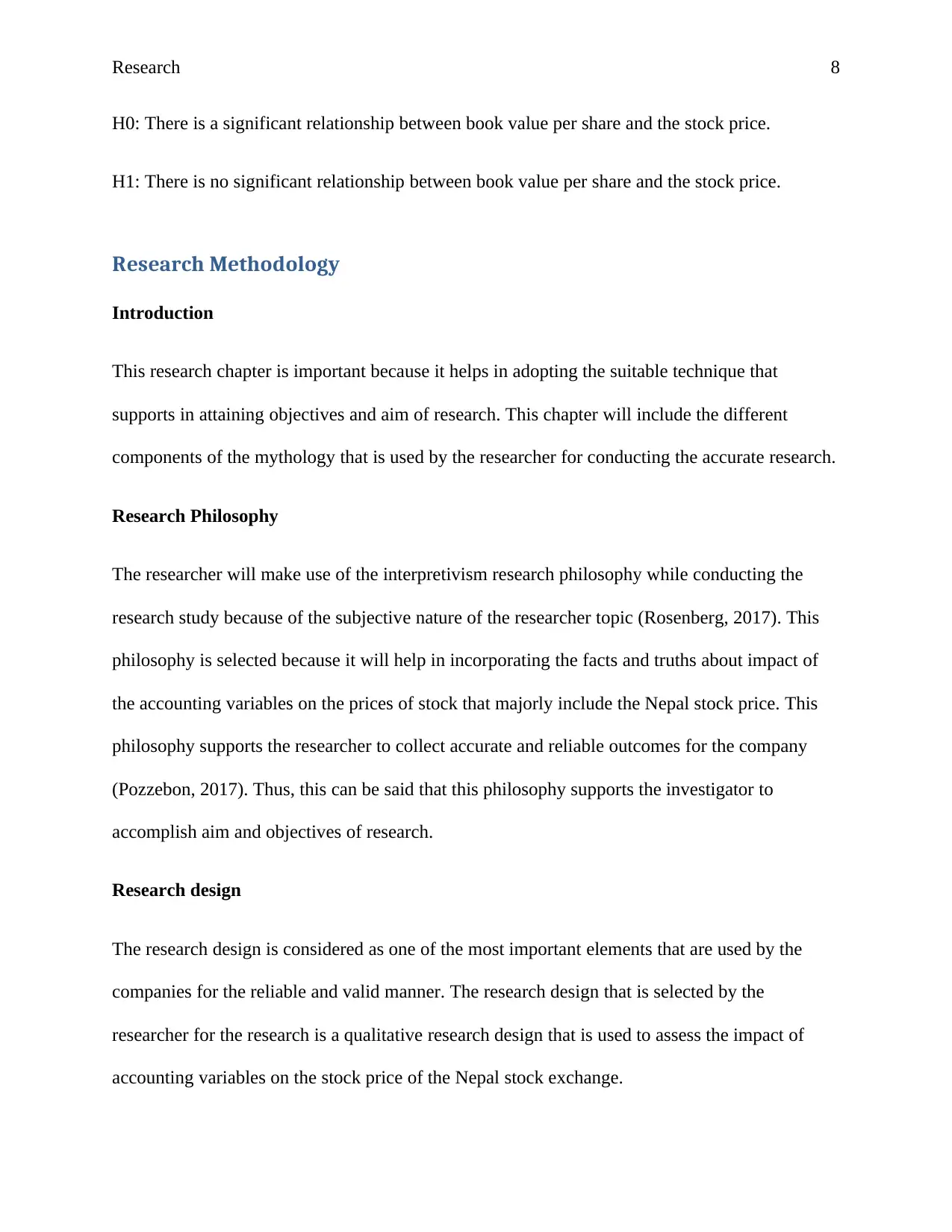
Research 8
H0: There is a significant relationship between book value per share and the stock price.
H1: There is no significant relationship between book value per share and the stock price.
Research Methodology
Introduction
This research chapter is important because it helps in adopting the suitable technique that
supports in attaining objectives and aim of research. This chapter will include the different
components of the mythology that is used by the researcher for conducting the accurate research.
Research Philosophy
The researcher will make use of the interpretivism research philosophy while conducting the
research study because of the subjective nature of the researcher topic (Rosenberg, 2017). This
philosophy is selected because it will help in incorporating the facts and truths about impact of
the accounting variables on the prices of stock that majorly include the Nepal stock price. This
philosophy supports the researcher to collect accurate and reliable outcomes for the company
(Pozzebon, 2017). Thus, this can be said that this philosophy supports the investigator to
accomplish aim and objectives of research.
Research design
The research design is considered as one of the most important elements that are used by the
companies for the reliable and valid manner. The research design that is selected by the
researcher for the research is a qualitative research design that is used to assess the impact of
accounting variables on the stock price of the Nepal stock exchange.
H0: There is a significant relationship between book value per share and the stock price.
H1: There is no significant relationship between book value per share and the stock price.
Research Methodology
Introduction
This research chapter is important because it helps in adopting the suitable technique that
supports in attaining objectives and aim of research. This chapter will include the different
components of the mythology that is used by the researcher for conducting the accurate research.
Research Philosophy
The researcher will make use of the interpretivism research philosophy while conducting the
research study because of the subjective nature of the researcher topic (Rosenberg, 2017). This
philosophy is selected because it will help in incorporating the facts and truths about impact of
the accounting variables on the prices of stock that majorly include the Nepal stock price. This
philosophy supports the researcher to collect accurate and reliable outcomes for the company
(Pozzebon, 2017). Thus, this can be said that this philosophy supports the investigator to
accomplish aim and objectives of research.
Research design
The research design is considered as one of the most important elements that are used by the
companies for the reliable and valid manner. The research design that is selected by the
researcher for the research is a qualitative research design that is used to assess the impact of
accounting variables on the stock price of the Nepal stock exchange.
⊘ This is a preview!⊘
Do you want full access?
Subscribe today to unlock all pages.

Trusted by 1+ million students worldwide
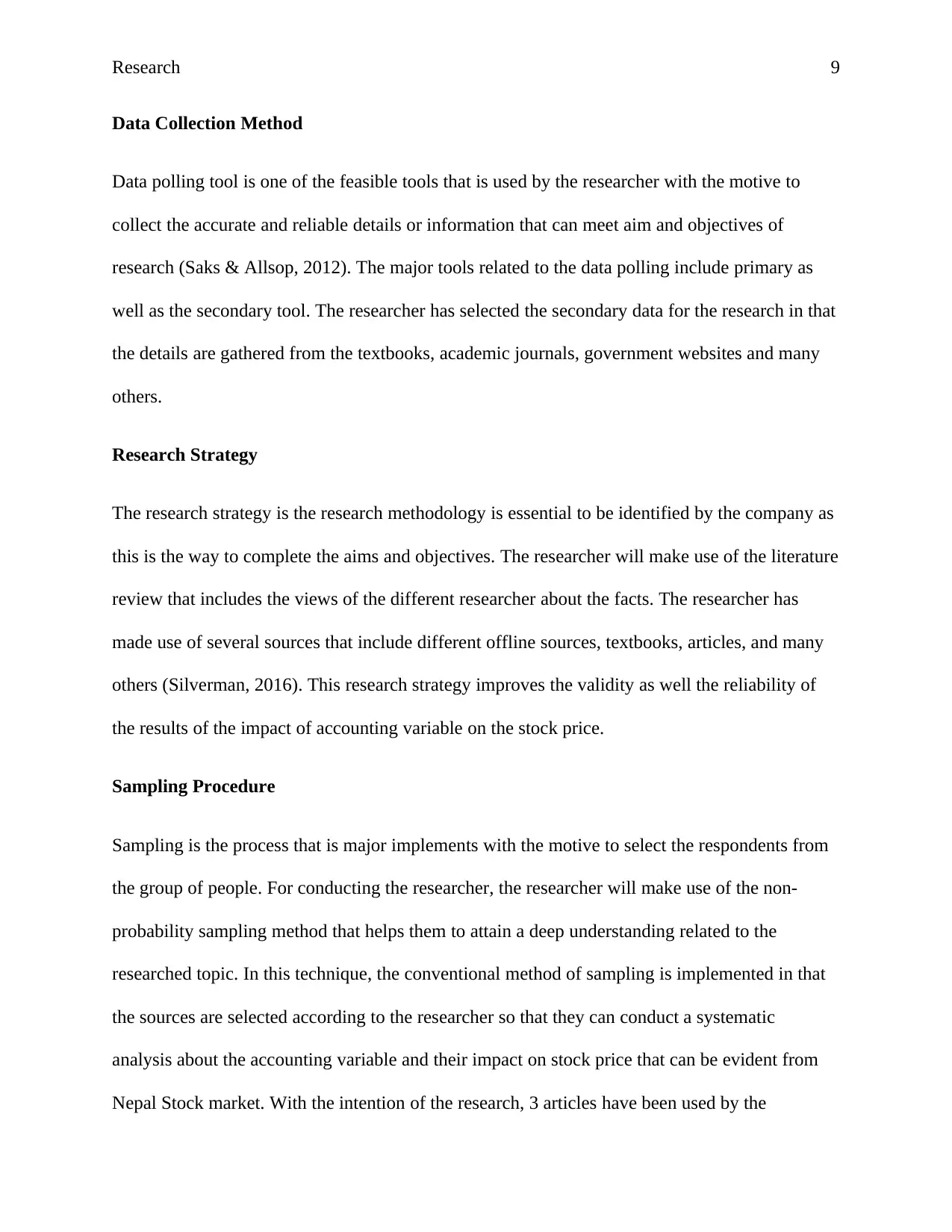
Research 9
Data Collection Method
Data polling tool is one of the feasible tools that is used by the researcher with the motive to
collect the accurate and reliable details or information that can meet aim and objectives of
research (Saks & Allsop, 2012). The major tools related to the data polling include primary as
well as the secondary tool. The researcher has selected the secondary data for the research in that
the details are gathered from the textbooks, academic journals, government websites and many
others.
Research Strategy
The research strategy is the research methodology is essential to be identified by the company as
this is the way to complete the aims and objectives. The researcher will make use of the literature
review that includes the views of the different researcher about the facts. The researcher has
made use of several sources that include different offline sources, textbooks, articles, and many
others (Silverman, 2016). This research strategy improves the validity as well the reliability of
the results of the impact of accounting variable on the stock price.
Sampling Procedure
Sampling is the process that is major implements with the motive to select the respondents from
the group of people. For conducting the researcher, the researcher will make use of the non-
probability sampling method that helps them to attain a deep understanding related to the
researched topic. In this technique, the conventional method of sampling is implemented in that
the sources are selected according to the researcher so that they can conduct a systematic
analysis about the accounting variable and their impact on stock price that can be evident from
Nepal Stock market. With the intention of the research, 3 articles have been used by the
Data Collection Method
Data polling tool is one of the feasible tools that is used by the researcher with the motive to
collect the accurate and reliable details or information that can meet aim and objectives of
research (Saks & Allsop, 2012). The major tools related to the data polling include primary as
well as the secondary tool. The researcher has selected the secondary data for the research in that
the details are gathered from the textbooks, academic journals, government websites and many
others.
Research Strategy
The research strategy is the research methodology is essential to be identified by the company as
this is the way to complete the aims and objectives. The researcher will make use of the literature
review that includes the views of the different researcher about the facts. The researcher has
made use of several sources that include different offline sources, textbooks, articles, and many
others (Silverman, 2016). This research strategy improves the validity as well the reliability of
the results of the impact of accounting variable on the stock price.
Sampling Procedure
Sampling is the process that is major implements with the motive to select the respondents from
the group of people. For conducting the researcher, the researcher will make use of the non-
probability sampling method that helps them to attain a deep understanding related to the
researched topic. In this technique, the conventional method of sampling is implemented in that
the sources are selected according to the researcher so that they can conduct a systematic
analysis about the accounting variable and their impact on stock price that can be evident from
Nepal Stock market. With the intention of the research, 3 articles have been used by the
Paraphrase This Document
Need a fresh take? Get an instant paraphrase of this document with our AI Paraphraser

Research 10
researcher as a sample size of the research (Smith, 2015). These research articles have been
selected after conducting the analysis of a different number of articles. Thus, this helps the
researcher to gather the facts in a consistent and accurate manner.
Ethical consideration
Ethical consideration is linked with the approach and tool that is required to be implemented by
the researcher so that they can avoid the chances related to the ethical concern. Thus, this is the
reason while conducting the secondary research the company take care of the different sources
that include an online website, books, journal and many others. These are also considered as the
sources that are implemented by the company with the motive to present the facts of the
information that has been collected.
Research limitation
In the research, there is the possibility of the different type of the limitation that is faced by the
researcher. All these limitations major include the time, resources, costs that are collected for the
figures and facts related to the research topic. The limitation related to the research might create
an impact on the validity of the reliability of the research.
The organisation of the Study
Organisational Structure would be suitable to accomplish the objectives and aim with the motive
to determine in a chronological way. The below-given structure would be applied for completing
the research methodical manner.
researcher as a sample size of the research (Smith, 2015). These research articles have been
selected after conducting the analysis of a different number of articles. Thus, this helps the
researcher to gather the facts in a consistent and accurate manner.
Ethical consideration
Ethical consideration is linked with the approach and tool that is required to be implemented by
the researcher so that they can avoid the chances related to the ethical concern. Thus, this is the
reason while conducting the secondary research the company take care of the different sources
that include an online website, books, journal and many others. These are also considered as the
sources that are implemented by the company with the motive to present the facts of the
information that has been collected.
Research limitation
In the research, there is the possibility of the different type of the limitation that is faced by the
researcher. All these limitations major include the time, resources, costs that are collected for the
figures and facts related to the research topic. The limitation related to the research might create
an impact on the validity of the reliability of the research.
The organisation of the Study
Organisational Structure would be suitable to accomplish the objectives and aim with the motive
to determine in a chronological way. The below-given structure would be applied for completing
the research methodical manner.

Research 11
Introduction
This chapter is the major research chapter where investigation will take in the light on problem
statement, aim and objectives related to the research question. This chapter is formed with the
motive to form the meaningful basis with the complex understanding that is in respects to the
topic of the research. The initial chapter includes deep knowledge about the scope of the project.
Thus, this chapter would be considered as an important chapter for the researcher to attain the
appropriate path for the research.
Literature Review
This is considered as the second chapter of the research that enables the literature review that
includes the opinions of the different authors with the motive to determine the concern associated
with the research (Mackey & Gass, 2015). The researcher remains capable enough to evaluate
the research conducted by the researcher for the influence of the accounting variables on the
stock prices that is evident from the Nepal stock exchange. Further, the secondary sources are
applied majorly with the motive to accumulate the data for the accounting variables and their
relationship with the prices of the stock in the Nepal stock market. These sources majorly include
the books, journals and other academic paper that can provide the insight of the research.
Research Methodology
This is the third chapter of the research that allows the researcher to make use of the different
types of the methodology, strategies, techniques that are must for accomplishing the researcher
in the effective and organised manner. The elements of the research methodology majorly
include sampling, strategy, philosophies, approaches and gathering of the information with the
help of tools.
Introduction
This chapter is the major research chapter where investigation will take in the light on problem
statement, aim and objectives related to the research question. This chapter is formed with the
motive to form the meaningful basis with the complex understanding that is in respects to the
topic of the research. The initial chapter includes deep knowledge about the scope of the project.
Thus, this chapter would be considered as an important chapter for the researcher to attain the
appropriate path for the research.
Literature Review
This is considered as the second chapter of the research that enables the literature review that
includes the opinions of the different authors with the motive to determine the concern associated
with the research (Mackey & Gass, 2015). The researcher remains capable enough to evaluate
the research conducted by the researcher for the influence of the accounting variables on the
stock prices that is evident from the Nepal stock exchange. Further, the secondary sources are
applied majorly with the motive to accumulate the data for the accounting variables and their
relationship with the prices of the stock in the Nepal stock market. These sources majorly include
the books, journals and other academic paper that can provide the insight of the research.
Research Methodology
This is the third chapter of the research that allows the researcher to make use of the different
types of the methodology, strategies, techniques that are must for accomplishing the researcher
in the effective and organised manner. The elements of the research methodology majorly
include sampling, strategy, philosophies, approaches and gathering of the information with the
help of tools.
⊘ This is a preview!⊘
Do you want full access?
Subscribe today to unlock all pages.

Trusted by 1+ million students worldwide
1 out of 20
Related Documents
Your All-in-One AI-Powered Toolkit for Academic Success.
+13062052269
info@desklib.com
Available 24*7 on WhatsApp / Email
![[object Object]](/_next/static/media/star-bottom.7253800d.svg)
Unlock your academic potential
Copyright © 2020–2025 A2Z Services. All Rights Reserved. Developed and managed by ZUCOL.




